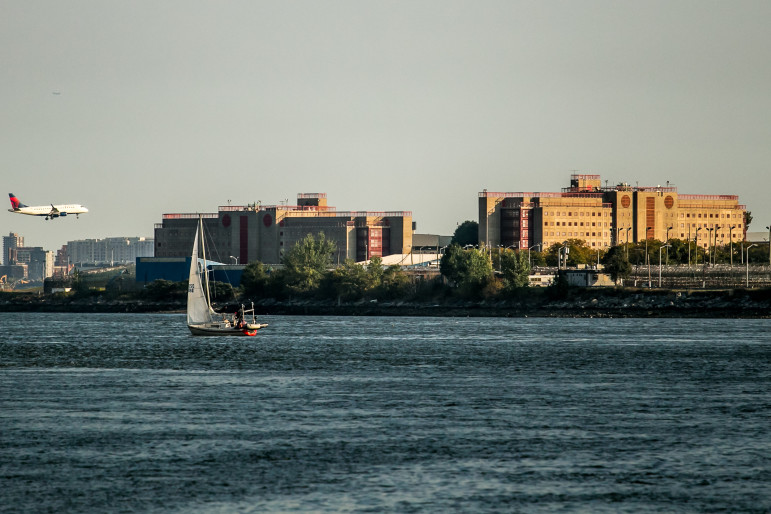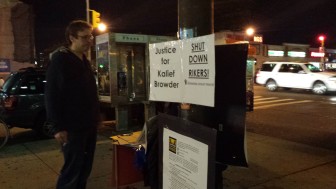
Adi Talwar
George R. Vierno Center on Rikers Island, seen from the Bronx. Deep concern about problems on the island is interwoven with a broader critique of the criminal-justice system.
The constant drumbeat of Justice Department reports, screaming headlines and impassioned editorials bemoaning the out-of-control violence and close to inhuman conditions on Rikers Island have been with us for over a year now. U.S. Attorney Preet Bharara’s report, issued in August 2014, dispassionately capped its central finding – that there is a “pattern and practice of excessive force and violence” at the city’s go-to holding pen for pretrial detainees and short-term inmates – with a foreboding conclusion: “Rikers Island is a broken institution. It is a place where brute force is the first impulse rather than the last resort.” The case of Kalief Browder, who spent three years at Rikers without being charged with a crime only to commit suicide last June, months after his release, seemed to bring to a tipping point the question of Rikers’ role in the city.
A federal lawsuit and the onslaught of bad press generated promises of reforms. But a growing chorus of politicians, former correction officials and commentators is now saying that Rikers is beyond saving.
“I think we should close Rikers, sell it, and build small community-based facilities,” says Jeremy Travis, president of the John Jay College for Criminal Justice and former director of the National Institute of Justice under President Bill Clinton. “This is not an new idea. It’s not something I’m shouting from the rooftops but I believe it’s an idea whose time has come.”
Actually achieving that goal will be difficult in the face of numerous obstacles, both political and practical – including the fact that in 2013 the city broke ground on a new jail on the island.
In some ways, however, the city is already winding down its reliance on Rikers. The island’s population has declined to just under 10,000 after cracking 20,000 in the early ’90s, and efforts to reform bail laws, treat mental illness outside of the correction system and speed up the courts have encouraged the notion that Rikers is increasingly obsolete. Meanwhile, arrests are declining, the state prison system is dwindling and a nationwide, bipartisan consensus has formed around the need for criminal-justice reforms that would have been unthinkable a decade or two ago.
The key question might not be whether the city should live without Rikers, or how it would do so, but whether it has the political will to finish the transformation that has already started.
Travis traces the idea to close Rikers Island back to his days as a member of the Koch administration in the 1980s. “Herb Sturz was the deputy mayor and he proposed a swap of Rikers with the state,” Travis says. “Then the idea was, the state was building up prisons, so why not keep those incarcerated individuals close to New York, and use the money to build a distributed network of smaller pretrial detention facilities throughout the city?” Travis says the idea never materialized because the state couldn’t come up with the money, but he felt it was a strong proposal because it would allow state inmates the chance to be closer to their city relatives and “give the city the opportunity to rethink and refocus attention to build a distributed network of small, presumably better designed, more humane and effective smaller facilities.”
As recently as Mayor Michael Bloomberg’s second term, the city tried to disperse the Rikers population to borough-based jails. Martin Horn, correction commissioner under Bloomberg and now a distinguished lecturer at John Jay, attempted to double the capacity of the Brooklyn Detention Complex in Boerum Hill, as well as build a $375 million jail in the South Bronx. Horn believed that dispersed jails in local settings would actually benefit the community. “It would be better for families and for justice – it would make the prisoners more accessible to the lawyers and social service organizations,” Horn says now. Neighborhood opposition torpedoed the move. “Everybody would wring their hands and say, ‘Yes, it’s terrible, Rikers Island stinks, but nobody wanted to do anything about it,'” Horn recalls.
The idea of closing Rikers in the face of the level of opposition encountered in 2007 would be “very unrealistic,” Horn says. But the politics surrounding the issue have changed over the past eight years. A few elected leaders openly support a move to close the island. One of them, Queens City Councilman Daniel Dromm, says putting together a plan to “demolish Rikers” is a win-win. “We know we’re going to have (not-in-my-backyard) objections but I think we have to educate the public about why it is important to keep facilities close to home and we need to have elected officials who can stand up and have the courage to say this is the right thing to do,” Dromm says.
Neil Barsky, a former Wall Street Journal reporter, hedge fund manager and founder of an investigative journalism site called The Marshall Project, jump-started the debate this summer with an op-ed in The New York Times. Invoking comparisons to Guantánamo Bay (the analogy came up again in a recent Marshall Project post by former Gov. Eliot Spitzer) and Rikers’ significance in the growing national debate on criminal justice reform, Barsky described the potential benefits of its closure on several big-picture levels. “I think it’s a great opportunity for Mayor de Blasio,” he said.
The political argument that advocates of closing Rikers make boils down to this: At a time when de Blasio is being battered by critics from the left and right, closing Rikers could be a crucial legacy-builder. While tabloid headlines scream about the perception of a spike in street crime, they have also painted Rikers as an evil that must be cured. The mayor has a chance to make a major statement in the country’s larger debate about criminal justice reform. And the island itself could even represent an opportunity for real-estate development with no risk of gentrification.
While much of the impetus for closing Rikers has come from policymakers and politicians, there is a growing grass-roots movement calling for change. Various groups like JustLeadershipUSA and the New York City Jails Action Coalition are part of a coalition that has circulated a petition on change.org calling for Rikers’ closing. A significant component of the activist movement is motivated by a recognition that blacks and Latinos are over-represented in the criminal justice system, a critique deeply woven into the evolving national debate about race.

Jarrett Murphy
Of course, de Blasio faces real obstacles to making a move to shutter Rikers. Besieged by the governor, charter networks, tabloid editorial boards, activists who feel he’s contracting with and hiring too few minorities, and a number of potential challengers from within his own party, de Blasio isn’t exactly rolling in political capital. His reforms of the bail system have been modest compared with what closing Rikers would involve, and critics have already accused him of being “soft on crime.” His greatest vulnerability has always been a rise in violence during his administration, and an uptick in the NYPD crime statistics could make closing Rikers all but impossible. Plus, the mayor already faces major fights over building affordable housing in certain neighborhoods; imagine the uproar in the communities where new jails would go.
So far, the de Blasio administration is not seizing on the opportunity. Instead, the city continues to put its faith in the reform process.
There has been a succession of jail-policy changes since the Times’ series on the abuse of mentally ill inmates in July 2014 and the release of Bharara’s report that August. By last November, de Blasio was promising more money to treat mental illness in the correction system. A few weeks into the new year the city’s Board of Correction adopted changes to the minimum standards governing life of Rikers, and in March the mayor and Correction Commissioner Joseph Ponte announced a 14-point plan to address violence on the island.
In late June, the city agreed to an additional set of reforms that included the end of solitary confinement for all inmates under 18 – Browder had spent months in solitary – and the installation of a federal monitor at the Department of Correction as part of a settlement in a lawsuit filed by Rikers inmates through the Legal Aid Society. The promised reforms included the use of body cameras by correction officers, increased video surveillance, a new use-of-force policy and new disciplinary guidelines. In addition, the settlement required the city to “make best efforts” to house inmates under 18 at facilities that would be accessible by public transit and allow for direct supervision.
On Oct. 7, the mayor quietly signed new legislation mandating additional Department of Correction reforms. Among other changes, the bills established reporting requirements involving statistics on inmate demographics, the use of segregated housing units, visitation, bail amounts, sentence lengths and inmate grievances. An inmate “bill of rights” and a public posting of the department’s use-of-force policy are also now required.
The reforms have had mixed results so far. The end of solitary confinement for detainees and inmates under 18 and the reforms in the bail system pursued by the City Council have at least symbolically addressed some of the problems. But just a few weeks ago internal emails were released showing that the Bronx district attorney’s office has a backlog of about 70 cases of violence from Rikers and appears overwhelmed. A new lawsuit was filed by a jail visitor who claimed she was groped by a Rikers guard who made her take her clothes off in front of her 5-year-old daughter. While it’s only fair to give the reforms time to work, there was a spike in violence at Rikers reported this July, and a newly released report by city Comptroller Scott Stringer’s office asserts that violence has exploded as the inmate population has declined.
The reforms implemented so far seem like common-sense measures, offering more reporting and transparency and an end to the practices most prone to abuse. But they mirror the policies being used to reduce incidents of excessive force by police – a reliance on technology here, a changing of codes there. The question for both sets of initiatives is whether they address the systemic issues at play. It seems unlikely that any modest reform will change the essential fact that Rikers is a dumping ground for pretrial detainees mired in a disgracefully slow case-processing system, a poorly suited home to thousands of the mentally ill, and a decaying physical asset on an isolated island that makes life difficult for everyone involved.
What’s needed, says John Jay’s Travis, is for the city to wipe the board and start over.
“Let’s think creatively about a system that treats individuals with dignity, gives corrections officers a good working environment, provides opportunities for people that are mentally ill to be treated like mental patients rather than inmates, treats young people differently and maybe not there at all – and let’s do the visioning exercise that says in 10 years, where do we want to be?” Travis says. “If we did that, we would not want to keep Rikers.”
READ PART II:
How NYC Got Rikers and Why it Doesn’t Work










2 thoughts on “Behind the Growing Calls to Close Rikers Island”
Great article! Thanks for the mention of the Campaign to Shut Down Rikers’ petition.
For those who haven’t already, please sign & share our petition: https://www.change.org/p/bill-de-blasio-andrew-cuomo-joseph-ponte-shut-down-rikers
#ShutDownRikers
Don’t shut it down. It’s an isolated location, hard to escape from, perfect to keep criminals in. Spreading them around will only ruin neighborhoods.